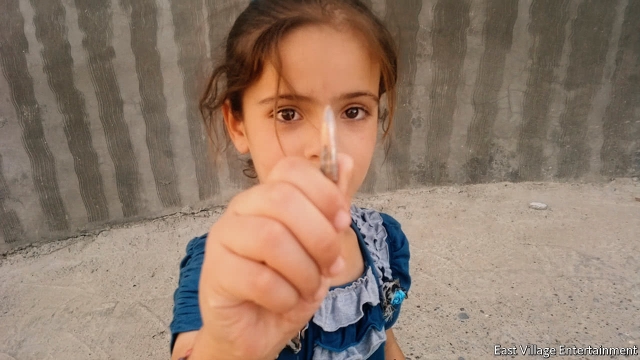The state of Kurdish cinema

WHEN Zaradasht Ahmed, a Norwegian-Kurdish director, began shooting his war documentary, a complicated process spanning more than five years awaited him. “Nowhere to Hide” (2016, pictured), an immersive account of a male nurse working and raising a family in Iraq, was shot collaboratively by Mr Ahmed and the nurse himself, Nori Sharif. Living in the “no-go” zone of Jalawla, Mr Sharif could access people and places which organisations and journalists could not. Mr Ahmed taught him how to film—and ended up taking the documentary in a whole new direction.
Although the Kurds’ contributions to defeating Islamic State (IS) turned the world’s eye on this population of 40m—spread across Turkey, Syria, Iraq and Iran—little is known about their creative cultural output. For decades, politics made it nearly impossible for them to make films: the Kurdish language was banned in places, poverty was rife, and the Iraqi-Kurdish civil war lasted throughout the 1990s.
But in recent years, Erbil, the largest city in the Kurdish autonomous region in Iraq, has seen both a state- and citizen-led cultural revival that has buoyed its film industry. Artrole, an international organisation facilitating cultural links with the Middle East, found that the lack of a formal arts infrastructure in the region has resulted in artist-led initiatives and self-organised groups. Meanwhile, the Kurdistan Regional Government (KRG) has sought to position Erbil as a regional destination: a joint Iraqi-Lebanese project opened 14 new movie theatres there in 2013, and it was named the 2014 Arab Capital of Tourism. These developments introduced newcomers to low-budget film- and documentary-making.Kurdish film-makers have a small but celebrated legacy to draw on. Yilmaz Güney laid the groundwork in the 1980s; his Palme d’Or-winning film “The Road” (1982) was a poetic realist film depicting hardship in south-eastern Turkey. Bahman Ghobadi, having assisted Abbas Kiarostami, an Iranian auteur, saved his earnings to make the first Kurdish-language feature “A Time for Drunken Horses” (2000). Jano Rosebiani sold production equipment to the Iraqi Ministry of Culture to fund “Chaplin of the Mountains” (2013). These were stories of daily
struggles and of coming of age.
The region’s film-makers are now engaging with conflicts both past and present. “14 July” (2017), directed by Haşim Aydemir, is a stirring but edifying retelling of a 1980 hunger strike by Kurdish prisoners. Apo Bazidi’s documentary “Resistance is Life” (2017), set in a refugee camp on the Turkish-Syrian border, follows an 8-year-old girl who idolises the female Kurdish fighters taking on IS. These films have tended to designate ambiguous figures as martyrs, and strip the nuance from complicated events.
So it is Kurdish artists in the global diaspora that are making the most exciting and varied new work. Many now dual citizens, they have grown up with access to a film-making education, affordable digital equipment and international contacts. The funding that comes from production companies based in Germany, Turkey and the Netherlands, as well as European cultural institutions, is obviously not subject to the fluctuating circumstances of their homeland. The fifth Duhok International Film Festival (DIFF)—“a bridge between Kurdish film production and worldwide film-making”—was supported by the Goethe Institute and Cinema for Peace.There are no heroes or neat resolutions in the haunting Iraqi-Kurdish production “A Dream Before Dying” (2017), which follows a bomb disposal technician working for the allies against IS and offers a vivid portrait of the psychological cost of war. The Kurdish-Dutch feature “Radio Kobani” (2017) has no flag-waving, but plenty of heart: it shines a light on the simple heroism of a young Kurdish woman who sets up a radio station in the devastated Syrian town, giving surviving inhabitants a voice.Many of these diasporic works search for a return, and probe questions of belonging. “Beyond Dreams” (2017), directed by Rojda Sekersoz, a Swedish Kurd, screened at DIFF to high acclaim. It tells the story of Mirja, a young ethnic Kurdish woman putting her life in Stockholm back together after jail time. In “Zer” (2017, pictured above), a man journeys from New York to the Kurdish heartlands to trace his grandmother’s story; a similar tale of self-discovery, home seems to hold every promise yet resolves little.The Kurds’ controversial independence referendum, followed by the dramatic conflict over Kirkuk, brings much uncertainty. The instability in the region may well bring this cinematic revival to a pause—but such setbacks have long dogged Kurdish attempts at cultural expression. Further migration from the region, meeting a productive diaspora, may actually allow more Kurdish voices to be heard. They are often worth listening to.